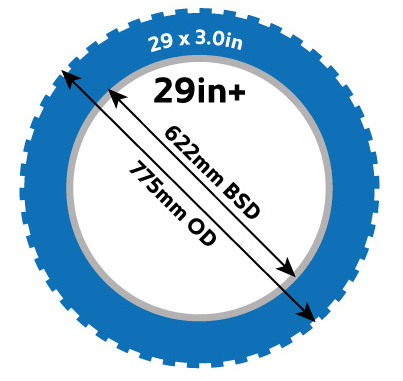Which MTB wheel size?

In the beginning mountain bikes had 26 inch wheels, developed from beach cruiser wheels with wider tyres fitted by the Californian pioneers of mountain bikes. However as the commercial market grew and different styles and terrains were conquered wheels have been redeveloped and redesigned to cope with differing demands and to set manufacturers apart from the competition.
Now wheel sizes from 26, 650b, 650b+, 29 and 29+ are common place on the trails and showrooms throughout the UK. Each of these tyres sizes offer different pro and cons depending on your riding style and different terrains you may wish to throw your bike at.
But which wheel sizes is right for you? The following article will give you some insights and help you understand the differences.

26 inch
The advantages of these wheels are they are very strong and light because they are small and compact. As they are so light they accelerate up to speed quickly. The small diameter allows for tight turns and extremely agile handling because of their low rotational mass, which gives the whole bike a nippy vibe but still leaving the rider feeling in full control.
The dis-advantages are a bumpy ride as the wheels can ride into dips and hollows where as larger wheels roll over the obstacles.
26inch wheels have now largely been replaced with 650b (27.5inch) wheels and you will be hard pushed to find a new showroom bike with these wheels.
Having said that, 26" wheel sizes can be a really good choice for the shorter adult rider or 'betweenagers' who find a 27.5 a tad of a physical stretch too far.

27.5 inch (650b)
This wheel size is probably the most popular size as it completely revolutionised the wheel market with the creation of an "all rounder" wheel that had the nimble agility of a 26 inch and some of the rolling ease and great traction of a 29er.
Quick turning, agile, versatile and fast - 27.5" offers a great middle ground for many riders and that's why its attained so much success in a relatively small space of time. The best of both worlds is what it is all about with 27.5" and with the majority of cyclists still more accustomed to 26", a 27.5" wheel provides a natural step-up. Riders going from a 26" to a 29" often find it hard to get used to due to the increased speed in which the bike travels affecting braking distance, corner speed and riding position. 27.5" has also become the standard on long travel trail and DH bikes, moving away from the 26" but maintaining the strength and steering accuracy whilst improving the frames rollover qualities.

29 inch (29er)
29" wheels were introduced as a way to bring more speed to mountain biking and have been around longer than many people think. 29ers roll much faster over the ground than their 27.5/26" counterparts. This wheel diameter gives increased overall speed, and enhances the stability of the bike over changeable terrain whilst also providing more traction to the wheel in tight corners.

27.5 inch+ (650b+)
This is the same diameter wheel as a 650b but with a wider rim allowing 3.0 inch wide tyres to be fitted, this allows for more traction and far superior handling. Frames and forks usually need to be of a correct width to allow for the wider tyres to be fitted without rubbing, so retro fitting these to an old frame is not usually an option. This gives the same outside diameter wheel tyre setup as a standard 29er fitted with a 2.3 inch tyre.

29 inch+ (29+)
This is the same diameter wheel as a standard 29 but with a wider rim allowing 3.0 inch wide tyres to be fitted, this allows for more traction and far superior handling. Frames and forks usually need to be of a correct width to allow for the wider tyres to be fitted without rubbing, so retro fitting these to an old frame is not usually an option.

Summary
The best and really the only way to find out which wheel size suits you the best is to have a test ride at Zero bikes or come on one of our organised demo events at a local bike park where you can really put them to the test.
Book by emailing us using our contact form
or ring 01531 584005

